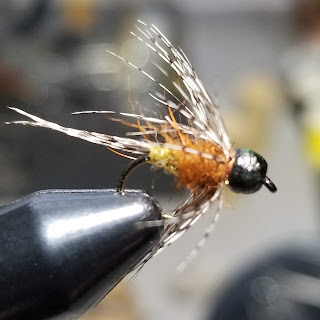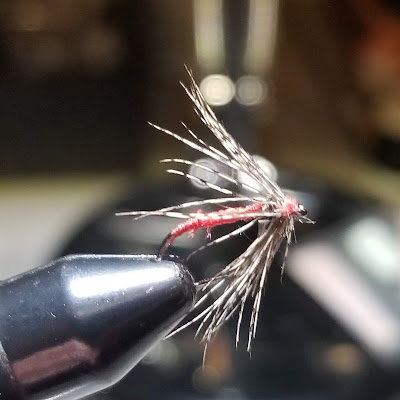Last week Dave P wrote in the comment section wondering how I deal with snowshoe hare. This stuff can be difficult for the novice fly tier. First, how much do I use for a well proportioned fly? Second, what part of the hares foot is best to use?
The little homemade tool on the left will show you how much to use. The late Ray Holden of Athol, a superb tier (how about a size 28 quill wing Royal Coachman), showed me a trick years ago. Pictured here is a size 16 hook whip finished to a tiny dowel. The size 16 hook will capture the right amount of feather to make a single quill wing(see photo below)
It can also be used for deer hair and SNOWSHOE too.
The third photo is rather poor but it gets the message across. If I haven't used snowshoe in a while I'll break out the "hook" and I'll know exactly how much to cut.
Now, what part of the foot is best???
The bottom photo shows a hares foot right side up. You want to be interested in the sole and heel of the foot AND around the toes of the foot. This is the fur that FLOATS!!! The stuff on the top of the foot has little floating properties.
Good Bye 2019
2019 has been a good year. From salmon in January to great dry fly fishing in the summer to the brookie run this Fall, everything just seemed to come together. Guiding and fly tying was up over the previous year but most of all this blog just continued to grow.
Without a doubt, this blog has the most page views and the most/best reader comments of any owner operated blog in New England. And what's very cool is that readers visit this blog EVERY DAY and if they discover this blog on the web THEY COME BACK. They come back
because this site will give you up to date flow conditions on area rivers, will let you know what's hatching and WHERE it's hatching such as Hendricksons in early May, Sulphurs in June and Tricos in August. I will continue to highlight sections of rivers just to make it easier for readers and with over 1000 square miles of watershed that I report on I will not be causing any overcrowding.
So have a Happy New Year and try to fish more and keep reading this blog!!!









































